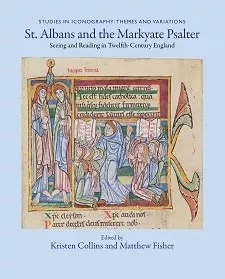- Author Resources
-
- Christianities before modernity
- Early Drama, Art, and Music
- Festschriften, Occasional Papers, and Lectures
- Late Tudor and Stuart Drama
- Ludic Cultures, 1100-1700
- Monastic Life and Venerated Spaces
- Monsters, Prodigies and Demons
- New Queer Medievalisms
- Northern Medieval World
- Old English Newsletter Subsidia
- Premodern Transgressive Literatures
- Research in Medieval and Early Modern Culture
- Publications of the Richard Rawlinson Center
- Studies in Iconography: Themes and Variations
- Studies in Medieval and Early Modern Culture
- Index - Books by author
- Index - Books by title
- Newsletter
- Directory
- Contact Us
Medieval Institute Publications
Western Michigan University
Kalamazoo MI 49008-5432 USA
+1 (269) 387-8755
Studies in Iconography: Themes and Variations
![An empty frame for a portable reliquary icon dating to 1347, made of wood, modeled gesso, verre églomisé, glass cabochons, and relics. Surrounding the empty space within the frame are seventeen relics, still visible. A Latin inscription around the base reads: This work has been made under the year of the Lord CCCXLVII [1347] in the time of the Lord Mini/Cini. The coats of arms of Cinughi and the hospital are visible on the base. Another inscription, LUCAS ME FECIT (Luke made me), is written on both sides.](https://files.wmich.edu/s3fs-public/styles/medium/public/2024-08/sitv_0.png?itok=BWWV_8GO)
Studies in Iconography: Themes and Variations is a companion series to the respected journal "Studies in Iconography." Volumes focus on the visual culture of the period before 1600. Submissions are welcomed for monographs or tightly-conceived essay collections that take a cross-disciplinary or interdisciplinary approach to their subjects or that examine theories and methods of iconographic analysis and histories of representation from a critical perspective.
Keywords: art history, iconography, visual culture, medieval, late antique
Geographical scope: Global
Chronological scope: Late antique to ca. 1600
- Diliana Angelova, University of California - Berkeley, Series Editor
- Pamela A. Patton, Princeton University, Series Editor
- Adam Cohen, University of Toronto
- Blake de Maria, Santa Clara University
- Martha Easton, St. Joseph’s University
- Maria Evangelatou, University of California, Santa Cruz
- MarĂa Judith Feliciano, Independent Scholar and Director, “Medieval Textiles in Iberia and the Mediterranean”
- Beatrice Kitzinger, Princeton University
- Alka Patel, University of California, Irvine
- Debra Higgs Strickland, University of Glasgow
- Thelma Thomas, Institute of Fine Arts, New York University
Proposals or completed manuscripts to be considered for publication by Medieval Institute Publications should be sent to Tyler Cloherty, the acquisitions editor for the series, or to the series editors. The series' editorial board is hosted by the Index of Medieval Art at Princeton University.
All Books in this Series

Reassessing Alabaster Sculpture in Medieval England
Edited by Jessica Brantley, Stephen Perkinson and Elizabeth C. Teviotdale
This volume offers fresh approaches to the material and the subject matter of late medieval English alabaster sculptures, bringing them into dialogue with twenty-first-century scholarship on pre-modern visual culture. The book comprises an introduction by Brantley and Perkinson; eight essays by scholars trained in the history of medieval art and/or medieval English literature, including Brantley and Perkinson; and an afterword by Paul Binski.
ISBN 978-1-50151-812-6 (clothbound), © 2021

The Locus of Meaning in Medieval Art
Edited by Lena Eva Liepe
This book addresses the status and relevance of iconography and iconology in the post-Panofskian study of medieval art. These disciplines remain crucial for the continued praxis in the discipline. The essays within this collection demonstrate the continued usefulness of iconography and iconology as analytical strategies, and propose alternative approaches to investigating the meaning of medieval art.
ISBN 978-1-58044-343-2 (clothbound) © 2019

St. Albans and the Markyate Psalter
Edited by Kristen Collins and Matthew Fisher
This collection offers bold new readings of the images, composition, reception, and contexts of the beautiful, twelfth-century Markyate Psalter.
ISBN 978-1-58044-258-9 (clothbound) © 2017

New Perspectives on the Man of Sorrows
Edited by Catherine R. Puglisi and William L. Barcham
This volume is a collection of ten essays investigating an assortment of issues and problems raised by the Man of Sorrows, a figure charged with profound spiritual, metaphorical, and symbolic meaning that traveled across Europe, populated all the arts, and permeated numerous religious contexts as it soared in popularity in the West from the late Middle Ages into the Renaissance and beyond.
ISBN 978-1-58044-193-3 (clothbound) © 2013



